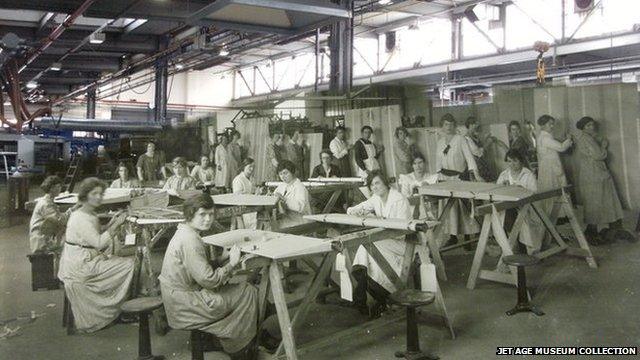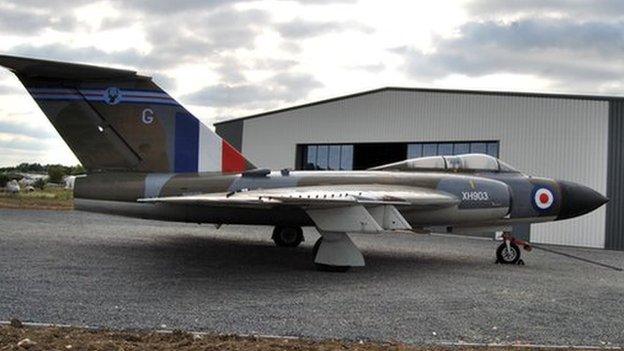World War One: HH Martyn turns from luxury liners to war planes
- Published

Workers at HH Martyn, Gloucester, during World War One and the factory as it is now
World War One was the first conflict to be waged on an industrial scale, and changed forever the face of British manufacturing. One firm in Gloucestershire switched from fitting out luxury liners to making war planes, beginning a link with hi-tech aircraft manufacture that continues to this day.
The transformation of Cheltenham-based HH Martyn, and the workforce it employed, sums up the impact World War One had on the country's economy.
The use of aircraft as a weapon of war expanded massively during the war.
HH Martyn's highly skilled woodworkers were ideally suited for making war planes.
By the end of the war, they had completed around £1.5m worth of government contracts for aircraft and employed 780 people, including many women doing skilled work.
It was the beginning of a link to cutting-edge aviation work that would eventually produce Britain's first jet fighters.
But the end of the war also saw the firm embroiled in a bitter row with the government over compensation for cancelled orders - a dispute that almost drove the firm into liquidation.
John Whittaker, the great-grandson of founder Herbert Henry Martyn, said the firm made panelling for luxury liners including the Lusitania, the sinking of which by a U-boat in 1915 helped bring the US into the war.
Ross Mahoney, the Royal Air Force Museum's aviation historian, their woodworking expertise gave them the chance to move into the fledgling aircraft manufacturing industry.
"Aircraft at this time were constructed over wooden frames and lined with canvas that was then doped to strengthen the materials," he explained.
Mr Whitaker said the firm advertised for women "capable of doing good needlework" to work sewing the canvas to the wooden airframes.
One female worker taken on was the wife of John Claridge, a manager at the firm.
Mrs Claridge said the work involved two women standing on either side of a ribs of a wing passing 12in (30cm) long needles to each other:

The firm advertised for skilled needle workers to stitch the canvas to the wooden frames of the aircraft
"The first girl would then make a knot and repeat the process all along the rib, back and forward.
"When the fabric was stitched securely to the wood ribs and spars of wings, tails or fuselage it would go to the dope shop where it would be treated so that the fabric would stretch tight."
Dope was a kind of paint that would evaporate, hardening the canvas.
In one of the stranger health and safety measures, women working in the dope shop were given half a pint of milk a day to protect them from the harmful effects of the fumes.
They were also examined every fortnight by a doctor to ensure the fumes were not harming them.
Workers were paid £2.9s.0d (£2.45p) for 12-hour day shift starting at six in the morning - night shift workers got slightly more, £2.12s.0d (£2. 54p) to work from 18:00 to 06:00.
This labour intensive method of production made aircraft "high end products" according to Mr Mahoney, with each Bristol F2b Fighter produced by HH Martyn costing £1,350 (that would be £65,000 today).
Such was the demand the firm also started manufacturing at the Winter Gardens in Cheltenham and by the end of the war they were producing 45 aircraft a week.
They were preparing to produce an order for 300 aircraft when the Armistice was declared.

Production expanded into the Winter Gardens in Cheltenham
The government immediately cut the order size to 50 aircraft, and later told Martyn's they did not even want those.
But Martyn's had already bought the materials to make the aircraft, and still had a greatly expanded workforce.
So began a three-year wrangle over compensation, which almost forced the company out of business.
It may be a coincidence but it was not until 1922 that Winston Churchill, on behalf of the Government, wrote to HH Martyn to thank them for their war work.
Eventually the aircraft manufacturing side of the business was split off and into the Gloucestershire Aircraft Company - later renamed Gloster, as this was easier to spell and pronounce.

The planes made from canvas stretched over a wooden frame
The firm's story "marks an important chapter in the emergence of the aviation industry in the United Kingdom" according to Mr Mahoney.
"It gave birth to one of the country's leading aircraft manufacturers, Gloster - [they] were responsible for the development of the UK's first operational fighter jet, the Meteor."
After the war HH Martyn went back to making decorative woodwork, including building a whole palace for a Maharaja in India in 1929, and fittings for the Queen Mary liner.
After the House of Commons was bombed in World War Two the firm produced much of the woodworking for its restoration.
Martyn maintained their stake in Gloster until the company merged with Hawker in 1934, before eventually closing in 1971.
Listen to how a Somerset metal works turned from munitions to memorials after the war and whether WW1 nearly bankrupted Britain.
- Published2 August 2013

- Published22 April 2013
